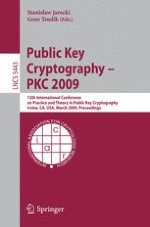2009 | Buch
Public Key Cryptography – PKC 2009
12th International Conference on Practice and Theory in Public Key Cryptography, Irvine, CA, USA, March 18-20, 2009. Proceedings
herausgegeben von: Stanisław Jarecki, Gene Tsudik
Verlag: Springer Berlin Heidelberg
Buchreihe : Lecture Notes in Computer Science
